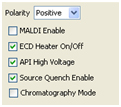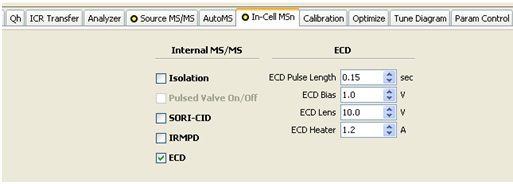In the process of ECD, the ESI-produced multiply protonated peptides and proteins, [M+nH]n+, capture a low-energy (<0.2eV) electron to produce the odd-electron ion [M+nH](n-1)+., which dissociates via an energetic H transfer to the backbone carbonyl group to form c and z sequence ions.
ECD is a mild fragmentation technique and is often used for analysis of post-translational modifications; it is also preferentially used for top-down analysis of proteins, no larger than 35 kDa. The electrons produced by the hollow cathode are pulsed into the ICR cell, which causes fragmentation of the ions which are already trapped in the ICR cell.
Conditioning and Operating the ECD Cathode
WARNING: Never operate the dispenser cathode without high vacuum (> 10-8 mbar) in the analyzer part of the instrument. Damage to the cathode may result.
WARNING: The heating of the cathode to the final temperature should be done slowly because of possible damage of the heater and the dispenser cathode. The full regeneration takes up to 12h. Please follow the instructions carefully.
Cathod Regeneration
1. Load a non-ECD method.
2. Activate the ECD heater on/off switch.

3. Activate ECD in the Internal MS/MS section of the MS/MS tab.

4. Slowly increase the ECD Heater current in 0.1A steps and at the same time watch the pressure in the UHV; if the pressure starts to rise wait until it starts dropping again before you increase it by the next 0.1A.
5. When you reached 1.5A leave this setting and allow the cathode to outgas for the next 12 hours (typically done overnight).
6. After this extended period of time the pressure in the UHV should drop back into the lower 10-9 or upper 10-10 mbar range.
Cathode Operation
If the cathode has already been regenerated the user should nevertheless carefully prepare the instrument for an ECD experiment, especially if the ECD cathode has not been in operation for some time (e.g. several days).
Check the ECD box in the Internal MS/MS section of the MS/MS tab and slowly increase the ECD Heater current to 1.5A (not faster than 0.2 A/min). Be careful to increase the current of the dispenser cathode heater slowly! While heating the cathode always monitor the pressure in the analyzer region, it should not exceed 10-8 mbar!
The short increase of the heating current to a higher value than the setting during operation is needed for surface activation of the dispenser cathode. After finishing the heating process, the activation of the surface can take several more minutes.
During this operation the acquisition of mass spectra for accurate mass measurements should not be carried out. This is due to the hot dispenser cathode resulting in an increase of the pressure in the analyzer cell, which will affect signal intensity, signal shape and mass accuracy of the measurement.
ECD Measurement
Heat the dispenser cathode stepwise to the right temperature. Note: Whenever the Global switch is On and a method is loaded with ECD checked in the Internal MS/MS section of the MS/MS tab, the cathode current will be changed to the value of the method. However if the Global switch is turned Off, loading an ECD method will not turn on the cathode. In addition when apexControl is started, the software will check the last instrument state - if the cathode was turned on in the previous session of apexControl the Global switch will be set accordingly to the checked status.
The ECD measurement is performed in the same manner as other MS/MS measurements with and without peak isolation, however based on the electron capture process for dissociation only multiply charged ions can be fragmented.
Select the ECD checkbox in the Internal MS/MS column to active the pulsed ECD event within the acquisition - the Global switch does not active the ECD event within apexControl.
The typical values for the ECD Pulse Length of the electron beam can vary from 0.2s to 0.001s with ECD bias (ionization energy of electrons) of ≈1.0-3.0V. However, the ECD Bias value for ECD operation correlates with the rear trapping potential in the ICR cell (Analyzer tab). Therefore, with high rear trapping potentials higher ECD Bias values are needed for the ECD measurements. ECD Lens parameter allows focusing of the electron beam and has a standard setting of ≈15.0V. Sidekick value (Analyzer tab) should be in the range of ±6V.
The ECD Heater parameter should be to the standard value of 1.6-1.8A as done previously during the procedure of stepwise heating the dispenser cathode to the final temperature for operation.
The correct setup of the parameters of the dispenser cathode for ECD can easily be done with the peptide substance P. The most intensive ECD fragment ion of substance P is the c5+ fragment with m/z 624. The values of ECD Pulse Length and ECD Bias should be adjusted for the highest intensity of this c5+ fragment However, too long of an electron beam length and a too high cathode potentials lead only to a decrease of the parent ion intensity and to the same intensity of the c5+ fragment ion. The general rule for tuning the ECD for other molecules is the larger the molecule the shorter the ECD Pulse Length and the higher the ECD Bias values.